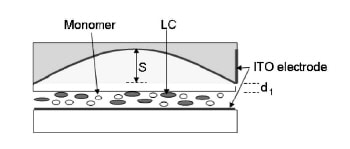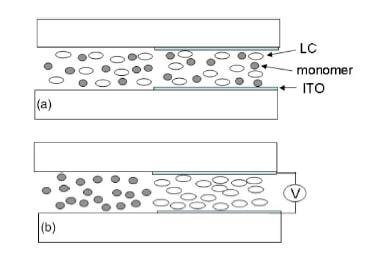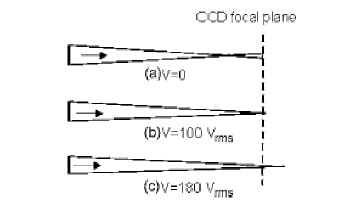Physicists in the US have created a new type of tuneable liquid-crystal lens, whose focus can be changed by varying the voltage applied to it. The new device is better than traditional liquid-crystal lenses because it only has small astigmatism and does not scatter light. It could be used for zoom lenses and other microphotonic devices (Appl. Phys. Lett. 88 191116).

Most liquid-crystal lenses exploit the fact that liquid-crystal molecules, which are shaped like tiny rods, can change the way they point in an electric field. In particular, if the field is big enough, they all line up in the direction of the field. This alters the refractive index — and hence the focusing power — of the material.
The new lens, which has been built by Shin-Tson Wu and colleagues at the University of Central Florida, allows the focus to be changed in a new way. The device consists of a mixture of liquid-crystal molecules and smaller N-vinylpyrrollidone monomers placed between two glass substrates, each of which is coated with a thin transparent layer of conducting indium tin oxide (figure 1). They then placed a concave glass lens with a flat base on top of one of the substrates.
Without any voltage, the liquid-crystal/monomer mixture was uniformly distributed throughout the gap between the substrates. But when the researchers applied a voltage across the two substrates, the liquid-crystal molecules clumped together at either end of the gap, where the electric field was higher, while the monomers moved towards the middle of the gap, where the field was lower (figure 2).
As a result of this concentration gradient, the refractive index varied across the device, being highest at the ends and lowest in the middle. The device therefore functioned as a lens, which the researchers proved by firing a helium-neon laser through it and focusing the light on a CCD camera. The researchers were able to increase the lens’s focal length simply by turning up the voltage across the device (figure 3).
Moreover, since no molecular reorientation is involved, the new lens overcomes some of the problems associated with conventional liquid-crystal lenses, such as strong astigmatism (when the lens cannot focus properly), distortion or light scattering during focus change.
The only snag with the new device is its long focusing time of about three minutes. This is because the lens is relatively large (9 mm), which means that molecular diffusion across it is slow. However, this should not be problem in micro-sized lenses in which the estimated response time is around 1 second at room temperature. The technique could also be used to make other adaptive microdevices such as prism arrays and phase gratings, say the researchers.





